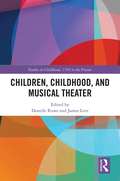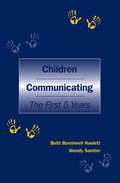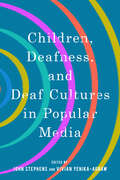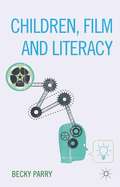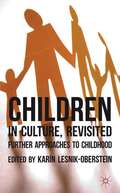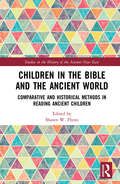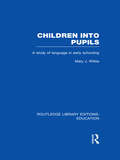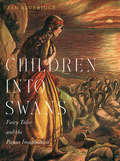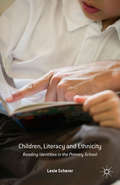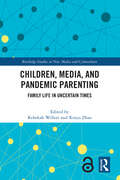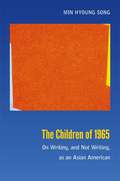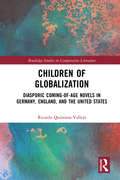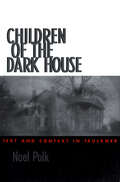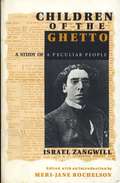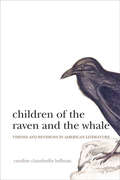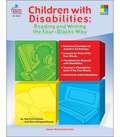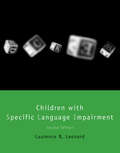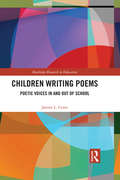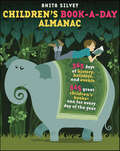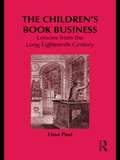- Table View
- List View
Children, Childhood, and Musical Theater (Studies in Childhood, 1700 to the Present)
by James Leve Donelle RuweBringing together scholars from musicology, literature, childhood studies, and theater, this volume examines the ways in which children's musicals tap into adult nostalgia for childhood while appealing to the needs and consumer potential of the child. The contributors take up a wide range of musicals, including works inspired by the books of children's authors such as Roald Dahl, P.L. Travers, and Francis Hodgson Burnett; created by Rodgers and Hammerstein, Lionel Bart, and other leading lights of musical theater; or conceived for a cast made up entirely of children. The collection examines musicals that propagate or complicate normative attitudes regarding what childhood is or should be. It also considers the child performer in movie musicals as well as in professional and amateur stage musicals. This far-ranging collection highlights the special place that musical theater occupies in the imaginations and lives of children as well as adults. The collection comes at a time of increased importance of musical theater in the lives of children and young adults.
Children Communicating: The First 5 Years (Routledge Communication Ser.)
by Wendy Samter Beth Bonniwell HaslettOffering a unique focus on the development of human communication, this book integrates and synthesizes a more comprehensive array of research than most investigations of communicative development. As such, it incorporates materials dealing with the development of nonverbal communication, language, and cognition, and examines how they are integrated in the growing child's everyday interaction. This information is distilled into a set of key principles and practices--culled from a variety of fields including developmental and social psychology, sociolinguistics, psycholinguistics, and communication--for parents or adults interested in child development. While this book does not offer an in-depth view in any one area, it provides a comprehensive overview of the various components of human communicative development and its significance for the child's cognitive and emotional growth. It is quite clear that developmental processes are constrained by multiple influences whose interactions have just begun to be uncovered. Examining the diverse facets of communicative development will enable professionals to garner further insights into the mystery of human communication.
Children, Deafness, and Deaf Cultures in Popular Media (Children's Literature Association Series)
by John Stephens and Vivian Yenika-AgbawContributions by Cynthia Neese Bailes, Nina Batt, Lijun Bi, Hélène Charderon, Stuart Ching, Helene Ehriander, Xiangshu Fang, Sara Kersten-Parish, Helen Kilpatrick, Jessica Kirkness, Sung-Ae Lee, Jann Pataray-Ching, Angela Schill, Josh Simpson, John Stephens, Corinne Walsh, Nerida Wayland, and Vivian Yenika-AgbawChildren, Deafness, and Deaf Cultures in Popular Media examines how creative works have depicted what it means to be a deaf or hard of hearing child in the modern world. In this collection of critical essays, scholars discuss works that cover wide-ranging subjects and themes: growing up deaf in a hearing world, stigmas associated with deafness, rival modes of communication, friendship and discrimination, intergenerational tensions between hearing and nonhearing family members, and the complications of establishing self-identity in increasingly complex societies. Contributors explore most of the major genres of children’s literature and film, including realistic fiction, particularly young adult novels, as well as works that make deft use of humor and parody. Further, scholars consider the expressive power of multimodal forms such as graphic novel and film to depict experience from the perspective of children. Representation of the point of view of child characters is central to this body of work and to the intersections of deafness with discourses of diversity and social justice. The child point of view supports a subtle advocacy of a wider understanding of the multiple ways of being D/deaf and the capacity of D/deaf children to give meaning to their unique experiences, especially as they find themselves moving between hearing and Deaf communities. These essays will alert scholars of children’s literature, as well as the reading public, to the many representations of deafness that, like deafness itself, pervade all cultures and are not limited to specific racial or sociocultural groups.
Children, Film and Literacy
by Becky ParryChildren, Film and Literacy explores the role of film in children's lives. The films children engage in provide them with imaginative spaces in which they create, play and perform familiar and unfamiliar, fantasy and everyday narratives and this narrative play is closely connected to identity, literacy and textual practices. Family is key to the encouragement of this social play and, at school, the playground is also an important site for this activity. However, in the literacy classroom, some children encounter a discontinuity between their experiences of narrative at home and those that are valued in school. Through film children develop understandings of the common characteristics of narrative and the particular 'language' of film. This book demonstrates the ways in which children are able to express and develop distinct and complex understandings of narrative, that is to say, where they can draw on their own experiences (including those in a moving image form). Children whose primary experiences of narrative are moving images face particular challenges when their experiences are not given opportunities for expression in the classroom, and this has urgent implications for the teaching of literacy.
Children in Culture, Revisited
by Karín Lesnik-ObersteinChildren in Culture, Revisited follows on from the first volume, Children in Culture , and is composed of a range of chapters, newly written for this collection, which offer further fully inter- and multidisciplinary considerations of childhood as a culturally and historically constructed identity rather than a constant psycho-biological entity.
Children in Immigrant Families Becoming Literate: A Window into Identity Construction, Transnationality, and Schooling
by Catherine Compton-Lilly Stephanie Shedrow Dana Hagerman Laura Hamman-Ortiz Yao-Kai Chi Jieun Kim Sun Young Lee Kristin Papoi Erin Quast Brooke Ward Taira Bingjie ZhengThis original book offers a meaningful window into the lived experiences of children from immigrant families, providing a holistic, profound portrait of their literacy practices as situated within social, cultural, and political frames. Drawing on reports from five years of an ongoing longitudinal research project involving students from immigrant families across their elementary school years, each chapter explores a unique set of questions about the students’ experiences and offers a rich data set of observations, interviews, and student-created artifacts. Authors apply different sociocultural, sociomaterial, and sociopolitical frameworks to better understand the dimensions of the children’s experiences. The multitude of approaches applied demonstrates how viewing the same data through distinct lenses is a powerful way to uncover the differences and comparative uses of these theories. Through such varied lenses, it becomes apparent how the complexities of lived experiences inform and improve our understanding of teaching and learning, and how our understanding of multifaceted literacy practices affects students’ social worlds and identities. Children in Immigrant Families Becoming Literate is a much-needed resource for scholars, professors, researchers, and graduate students in language and literacy education, English education, and teacher education.
Children in the Bible and the Ancient World: Comparative and Historical Methods in Reading Ancient Children (Studies in the History of the Ancient Near East)
by Shawn FlynnThe topic of children in the Bible has long been under-represented, but this has recently changed with the development of childhood studies in broader fields, and the work of several dedicated scholars. While many reading methods are employed in this emerging field, comparative work with children in the ancient world has been an important tool to understand the function of children in biblical texts. Children in the Bible and the Ancient World broadly introduces children in the ancient world, and specifically children in the Bible. It brings together an international group of experts who help readers understand how children are constructed in biblical literature across three broad areas: children in the Hebrew Bible and the Ancient Near East, children in Christian writings and the Greco-Roman world, and children and materiality. The diverse essays cover topics such as: vows in Ugarit and the Hebrew Bible, obstetric knowledge, infant abandonment, the role of marriage, Greek abandonment texts, ritual entry for children into Christian communities, education, sexual abuse, and the role of archeological figurines in children’s lives. The volume also includes expertise in biological anthropology to study the skeletal remains of ancient children, as well as how ancient texts illuminate Mary’s female maturity. The volume is written in an accessible style suitable for non-specialists, and it is equipped with a helpful resource bibliography that organizes select secondary sources from these essays into meaningful categories for further study. Children in the Bible and the Ancient World is a helpful introduction to any who study children and childhood in the ancient world. In addition, the volume will be of interest to experts who are engaged in historical approaches to biblical studies, while appreciating how the ancient world continues to illuminate select topics in biblical texts.
Children into Pupils: A Study of Language in Early Schooling (Routledge Library Editions: Education)
by Mary WillesThis book makes work in the field of sociolinguistics easily accessible to working teachers and to teachers in training. It focuses on the crucial first weeks that children spend in school, and deals with talk as a joint production, in which teachers and pupils are engaged from the earliest stages of the educational process. Using a variety of research methods and observations, Mary Willes captures the reality of what goes on in the classroom, and describes how young children develop both linguistic and cognitive skills in this social context. In addition, she examines classrooms where teachers have to find ways of interacting with young speakers of a mother tongue other than English.
Children into Swans
by Jan BeveridgeFairy tales are alive with the supernatural - elves, dwarfs, fairies, giants, and trolls, as well as witches with magic wands and sorcerers who cast spells and enchantments. Children into Swans examines these motifs in a range of ancient stories. Moving from the rich period of nineteenth-century fairy tales back as far as the earliest folk literature of northern Europe, Jan Beveridge shows how long these supernatural features have been a part of storytelling, with ancient tales, many from Celtic and Norse mythology, that offer glimpses into a remote era and a pre-Christian sensibility. The earliest stories often show significant differences from what we might expect. Elves mingle with Norse gods, dwarfs belong to a proud clan of magician-smiths, and fairies are shape-shifters emerging from the hills and the sea mist. In story traditions with roots in a pre-Christian imagination, an invisible other world exists alongside our own. From the lost cultures of a thousand years ago, Children into Swans opens the door on some of the most extraordinary worlds ever portrayed in literature - worlds that are both starkly beautiful and full of horrors.
Children into Swans: Fairy Tales and the Pagan Imagination
by Jan BeveridgeFairy tales are alive with the supernatural - elves, dwarfs, fairies, giants, and trolls, as well as witches with magic wands and sorcerers who cast spells and enchantments. Children into Swans examines these motifs in a range of ancient stories. Moving from the rich period of nineteenth-century fairy tales back as far as the earliest folk literature of northern Europe, Jan Beveridge shows how long these supernatural features have been a part of storytelling, with ancient tales, many from Celtic and Norse mythology, that offer glimpses into a remote era and a pre-Christian sensibility. The earliest stories often show significant differences from what we might expect. Elves mingle with Norse gods, dwarfs belong to a proud clan of magician-smiths, and fairies are shape-shifters emerging from the hills and the sea mist. In story traditions with roots in a pre-Christian imagination, an invisible other world exists alongside our own. From the lost cultures of a thousand years ago, Children into Swans opens the door on some of the most extraordinary worlds ever portrayed in literature - worlds that are both starkly beautiful and full of horrors.
Children Learning Second Languages
by Annamaria PinterChildren Learning Second Languages is a four-partcomprehensive guide to current research and debate related to second language learning in childhood, the age factor and the relationship between research and classroom practice. Part 1 covers child development, L1 and L2 language learning processes in childhood and offers a guide to contexts from foreign language learning at school to immersion education and bilingual/trilingual acquisition at home. Part 2 gives a bird's eye view of current research in the area of child SLA and pedagogy highlighting the strengths and weaknesses of different traditions and types of research. This is followed by a close examination of eight case studies. Part 3 is devoted to issues of future research priorities by discussing methodological and ethical difficulties in child focused research and outlining 15 feasible studies for the future. Part 4 offers some resources including hands-on teaching materials, handbooks, theoretical books, details of organizations and projects in the broad area of child second language learning. "
Children, Literacy and Ethnicity: Reading Identities in the Primary School
by Lexie SchererThis book explores children's meaning making of the books they learn to read with, especially relating to the intersections of race, gender and class. Based on research using a participative, innovative design with young children, issues of identity, belonging and classroom hierarchies are explored in complex and poignant ways by the children.
Children, Media, and Pandemic Parenting: Family Life in Uncertain Times (Routledge Studies in New Media and Cyberculture)
by Rebekah Willett Xinyu ZhaoThis book examines changes in families’ rules and routines connected with media during the pandemic and shifts in parents’ understanding of children’s media use.Drawing on interviews with 130 parents at the height of the COVID-19 pandemic, the book explores specific cultural contexts across seven countries: Australia, Canada, China, Colombia, South Korea, United Kingdom, and United States. Readers will gain an understanding of family media practices during the pandemic and how they were influenced by contextual factors such as the pandemic restrictions, family relationships and situations, socioeconomic statuses, cultural norms and values, and sociotechnical visions, among others. Further, encounter with theoretical framings will provide innovative ways to understand what it means for children, parents, and families to live in the digital age.This timely volume will offer key insights to researchers and graduate students studying in a variety of disciplines, including media and cultural studies, communication arts, education, childhood studies, and family studies.The Open Access version of this book, available at www.taylorfrancis.com, has been made available under a Creative Commons Attribution- Non Commercial- No Derivatives (CC- BY- NC- ND) 4.0 license.
The Children of 1965: On Writing, and Not Writing, as an Asian American
by Song Min HyoungSince the 1990s, a new cohort of Asian American writers has garnered critical and popular attention. Many of its members are the children of Asians who came to the United States after the Immigration and Nationality Act of 1965 lifted long-standing restrictions on immigration. This new generation encompasses writers as diverse as the graphic novelists Adrian Tomine and Gene Luen Yang, the short story writer Nam Le, and the poet Cathy Park Hong. Having scrutinized more than one hundred works by emerging Asian American authors and having interviewed several of these writers, Min Hyoung Song argues that collectively, these works push against existing ways of thinking about race, even as they demonstrate how race can facilitate creativity. Some of the writers eschew their identification as ethnic writers, while others embrace it as a means of tackling the uncertainty that many people feel about the near future. In the literature that they create, a number of the writers that Song discusses take on pressing contemporary matters such as demographic change, environmental catastrophe, and the widespread sense that the United States is in national decline.
Children of Globalization: Diasporic Coming-of-Age Novels in Germany, England, and the United States (Routledge Studies in Comparative Literature)
by Ricardo Quintana-VallejoChildren of Globalization is the first book-length exploration of contemporary Diasporic Coming-of-age Novels in the context of globalized and de facto multicultural societies. Diasporic Coming-of-age Novels subvert the horizon of expectations of the originating and archetypal form of the genre, the traditional Bildungsroman, which encompasses the works of Johann Wolfgang von Goethe, Charles Dickens, and Jane Austen, and illustrates middle-class, European, "enlightened," and overwhelmingly male protagonists who become accommodated citizens, workers, and spouses whom the readers should imitate. Conversely, Diasporic Coming-of-age Novels have manifold ways of defining youth and adulthood. The culturally-hybrid protagonists, often experiencing intersectional oppression due to their identities of race, gender, class, or sexuality, must negotiate what it means to become adults in their own families and social contexts, at times being undocumented or otherwise unable to access full citizenship, thus enabling complex and variegated formative processes that beg the questions of nationhood and belonging in increasingly globalized societies worldwide.
Children of the Dark House: Text and Context in Faulkner
by Noel PolkThis book by a major scholar of William Faulkner’s writings collects choice selections of his Faulkner criticism from the past fifteen years. Its publication underscores the significance of his indispensable work in Faulkner studies, both in criticism and in the editing of Faulkner’s texts. Here, Polk’s focus is mainly upon the context of Freudian themes, expressly in the works written between 1927 and 1932, the period in which Faulkner wrote and ultimately revised Sanctuary, a novel to which Polk has given concentrated study during his distinguished career. He has connected the literature with the life in a way not achieved in previous criticism. Although other critics, notably John T. Irwin and Andre Bleikasten, have explored Oedipal themes, neither perceived them as operating so completely at the center of Faulkner’s work as Polk does in these essays.
Children of the Ghetto: A Study of a Peculiar People
by Meri-Jane Rochelson Israel ZangwillIn its first appearance in 1892, Israel Zangwill's Children of the Ghetto created a sensation in both England and America, becoming the first Anglo-Jewish bestseller and establishing Zangwill as the literary voice of Anglo-Jewry. A novel set in late nineteenth-century London, Children of the Ghetto gave an inside look into an immigrant community that was almost as mysterious to the more established middle-class Jews of Britain as to the non-Jewish population, providing a compelling analysis of a generation caught between the ghetto and modern British life. This volume brings back to print the 1895 edition of Children of the Ghetto, the latest American version known to have been corrected by the author. Meri-Jane Rochelson places the novel in proper context by providing a biographical, historical, and critical introduction; a bibliography of primary and secondary sources; and notes on the text, making this ground-breaking novel accessible to a new generation of readers, both Jewish and non-Jewish alike.
Children of the Raven and the Whale: Visions and Revisions in American Literature
by Caroline Chamberlin HellmanTaking its cue from Perry Miller’s 1956 classic of American literary criticism, The Raven and the Whale: The War of Words and Wits in the Era of Poe and Melville, Caroline Chamberlin Hellman’s new book examines ways in which contemporary multi-ethnic writers of the United States have responded to nineteenth- and early twentieth century texts historically central to the American literary canon.Each chapter of Children of the Raven and the Whale looks down the roads American literature ultimately traveled, examining pairs and constellations of texts in conversation. In their rewritings and layerings of new stories over older ones, contemporary writers forge ahead in their interrogations of a spectrum of American experience, whether they or their characters are native to the United States, first- or second-generation immigrants, or transnational. Revealing the traces of texts by writers such as Walt Whitman, Herman Melville, Nathaniel Hawthorne, F. Scott Fitzgerald, Ernest Hemingway, Richard Wright, and James Baldwin lying beneath contemporary American literature by Chang-rae Lee, Jonathan Lethem, Jhumpa Lahiri, Junot Díaz, Joseph O’Neill, Colum McCann, and Ta-Nehisi Coates, Hellman posits the existence of a twenty-first-century American renaissance.
Children Tell Stories: Teaching and Using Storytelling in the Classroom
by Martha Hamilton Mitch Weiss Dede HatchThe revised edition of this award-winning guidebook on storytelling in the classroom includes over 80% new material. The authors provide compelling rationales for the value of storytelling, links to state literacy learning standards, detailed storytelling unit tips, easy ideas for storytelling throughout the curriculum, and carefully selected and extensive bibliographies. Considered the classic in the field, Children Tell Stories is useful to both experienced and novice teachers and storytellers who work with students from preschool through college.
Children with Disabilities: Reading and Writing the Four-Blocks Way
by Karen A. Erickson David A. KoppenhaverThis collection of ideas, strategies, and resources includes information on Self-Selected Reading, Guided Reading, Writing, and Working with Words. It also includes strategies for reading and writing success in special-education classrooms, variations for students with disabilities, teacher's checklists, IEP goal suggestions, examples of assistive technology, and answers to commonly asked questions.
Children with Specific Language Impairment (Language, Speech, and Communication)
by Laurence B. LeonardThe landmark reference in the field, completely updated: a comprehensive treatment of a disorder that is more prevalent than autism. Children with specific language impairment (SLI) show a significant deficit in spoken language that cannot be attributed to neurological damage, hearing impairment, or intellectual disability. More prevalent than autism and at least as prevalent as dyslexia, SLI affects approximately seven percent of all children; it is longstanding, with adverse effects on academic, social, and (eventually) economic standing. The first edition of this work established Children with Specific Language Impairment as the landmark reference on this condition, considering not only the disorder's history, possible origins, and treatment but also what SLI might tell us about language organization and development in general. This second edition offers a complete update of the earlier volume.Much of the second edition is completely new, reflecting findings and interpretations based on the hundreds of studies that have appeared since the publication of the first edition in 1997. Topics include linguistic details (descriptive and theoretical), word and sentence processing findings, genetics, neurobiology, treatment, and comparisons to such conditions as autism spectrum disorders, ADHD, and dyslexia. The book covers SLI in children who speak a wide range of languages, and, although the emphasis is on children, it also includes studies of adults who were diagnosed with SLI as children or are the parents of children with SLI.Written by a leading scholar in the field, Children with Specific Language Impairment offers the most comprehensive, balanced, and unified treatment of SLI available.
Children with Specific Language Impairment
by Laurence B. LeonardChildren with specific language impairment (SLI) show a significant deficit in spoken language that cannot be attributed to neurological damage, hearing impairment, or intellectual disability. More prevalent than autism and at least as prevalent as dyslexia, SLI affects approximately seven percent of all children; it is longstanding, with adverse effects on academic, social, and (eventually) economic standing. The first edition of this work established Children with Specific Language Impairment as the landmark reference on this condition, considering not only the disorder's history, possible origins, and treatment but also what SLI might tell us about language organization and development in general. This second edition offers a complete update of the earlier volume. Much of the second edition is completely new, reflecting findings and interpretations based on the hundreds of studies that have appeared since the publication of the first edition in 1997. Topics include linguistic details (descriptive and theoretical), word and sentence processing findings, genetics, neurobiology, treatment, and comparisons to such conditions as autism spectrum disorders, ADHD, and dyslexia. The book covers SLI in children who speak a wide range of languages, and, although the emphasis is on children, it also includes studies of adults who were diagnosed with SLI as children or are the parents of children with SLI. Written by a leading scholar in the field, Children with Specific Language Impairment offers the most comprehensive, balanced, and unified treatment of SLI available.
Children Writing Poems: Poetic Voices in and out of School (Routledge Research in Education #12)
by Janine CertoThis volume demonstrates how the social and instructional worlds that children inhabit influence their poetry writing and performances. Drawing on rich vignettes of students from different racial, ethnic and linguistic backgrounds, it describes and analyzes the work of eight to ten-year-old U.S. students involved in a month-long poetry unit. Children Writing Poems outlines the value of a ‘poetic-functional’ approach to help children convey a poem’s meaning and mood, and expresses the need for educators to scaffold children’s oral readings and performances over time.
Children's Book-a-Day Almanac
by Anita SilveyPart fun- and information-filled almanac, part good book guide, the Children's Book-a-Day Almanac is a new way to discover a great children's book--every day of the year!This fresh, inventive reference book is a dynamic way to showcase the gems, both new and old, of children's literature. Each page features an event of the day, a children's book that relates to that event, and a list of other events that took place on that day. Always informative and often surprising, celebrate a year of literature for children with The Children's Book-a-Day Almanac.
The Children's Book Business: Lessons from the Long Eighteenth Century (Children's Literature and Culture)
by Lissa PaulIn The Children’s Book Business, Lissa Paul constructs a new kind of book biography. By focusing on Eliza Fenwick’s1805 product-placement novel, Visits to the Juvenile Library, in the context of Marjorie Moon’s 1990 bibliography, Benjamin Tabart’s Juvenile Library, Paul explains how twenty-first century cultural sensibilities are informed by late eighteenth-century attitudes towards children, reading, knowledge, and publishing. The thinking, knowing children of the Enlightenment, she argues, are models for present day technologically-connected, socially-conscious children; the increasingly obsolete images of Romantic innocent and ignorant children are bracketed between the two periods. By drawing on recent scholarship in several fields including book history, cultural studies, and educational theory, The Children’s Book Business provides a detailed historical picture of the landscape of some of the trade practices of early publishers, and explains how they developed in concert with the progressive pedagogies of several female authors, including Eliza Fenwick, Mary Wollstonecraft, Anna Barbauld, Maria Edgeworth, and Ann and Jane Taylor. Paul’s revisionist reading of the history of children’s literature will be of interest to scholars working in eighteenth-century studies, book history, childhood studies, cultural studies, educational history, and children’s literature.
